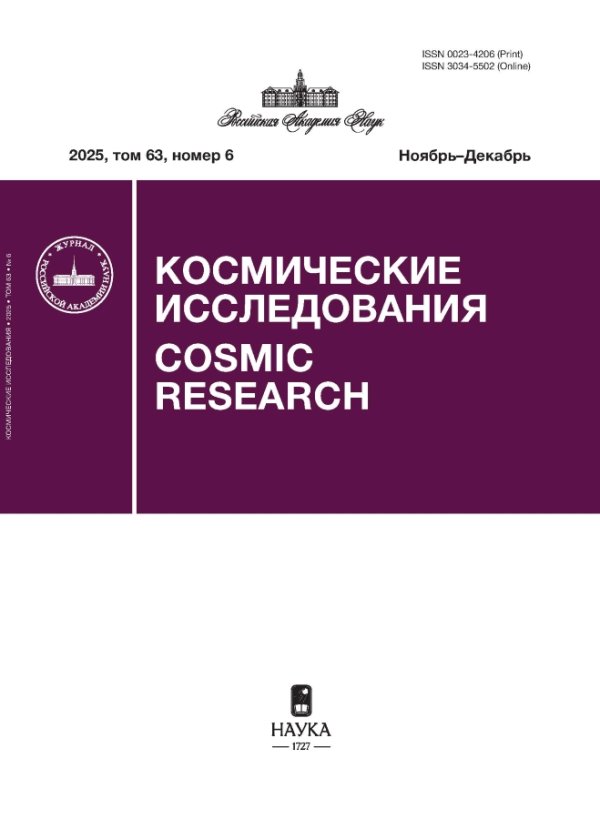A Study of the Feasibility of Using Accompanying Data-Relay Satellites in the Tasks of Providing Communication with Deep-Space Spacecraft
- Authors: Plokhikh A.P.1, Sinitsyn A.A.1
-
Affiliations:
- Moscow Aviation Institute (National Research University), 125080, Moscow, Russia
- Issue: Vol 61, No 6 (2023)
- Pages: 520-529
- Section: Articles
- URL: https://journals.rcsi.science/0023-4206/article/view/231831
- DOI: https://doi.org/10.31857/S002342062370019X
- EDN: https://elibrary.ru/CHESVL
- ID: 231831
Cite item
Full Text
Abstract
We have considered possible architecture options for an interplanetary communication system in which a data relay is used. The structure of a typical space communication link and the ways to improve its efficiency are analyzed. As one possibility, it is proposed to use accompanying orbital data-relay satellites providing the required data-transmission rate in the mode of formation flight together with the research spacecraft (SC). The optimization of the heliocentric leg of the flight trajectory of the Martian research SC and its accompanying data-relay satellite was carried out. The principal possibility of providing a formation flight of the data-relay satellite and research SC to improve communication with the Earth is demonstrated. Estimates were obtained for the masses of data-relay satellite and research SC with regard to the use of medium-lift launch vehicle of Soyuz type and a Fregat booster. Estimates are given for an increase in the duration of high-speed communication due to the use of a data-relay satellite in libration points L4 and L5 of the Earth–Sun system, as well as in heliocentric circular orbits with different radii.
About the authors
A. P. Plokhikh
Moscow Aviation Institute (National Research University), 125080, Moscow, Russia
Email: plokhikh2001@mail.ru
Россия, Москва
A. A. Sinitsyn
Moscow Aviation Institute (National Research University), 125080, Moscow, Russia
Author for correspondence.
Email: plokhikh2001@mail.ru
Россия, Москва
References
- Stampfl R.A., Jones A.E. Tracking and data relay satellites // IEEE Trans. Aerosp. Electron. Syst. 1970. V. AES-6. Iss. 3. P. 276–289.
- Toral M., Heckler G., Pogorelc P. et al. Payload performance of third generation TDRS and future services // Proc. 35th AIAA Int. Commun. Satell. Syst. Conf. ICSSC. 2017. Art. ID. AIAA 2017–5433. https://doi.org/10.2514/6.2017-5433
- Witting M., Hauschildt H., Murrell A. et al. Status of the European data relay satellite system // Proc. Int. Conf. Space Opt. Syst. Appl. (ICSOS). Ajaccio. France. 2012. P. 19–30.
- Hunter J. The orbiting deep space relay station – A study report. // Proc. AIAA Conf. Large Space Platforms: Future Needs Capabilities. Los Angeles. USA. 1978. Art. ID. 1639.
- Wilson K.E., Wright M., Cesarone R. et al. Cost and performance comparison of an Earth-orbiting optical communication relay transceiver and a ground-based optical receiver subnet // IPN Progress Rep. P. 42–153. 2003.
- Cornwell D.M. NASA’s optical communications program for 2017 and beyond // Proc. IEEE Int. Conf. Space Opt. Syst. Appl. 2017. P. 10–14. https://doi.org/10.1109/ICSOS.2017.8357203
- Cerf V., Burleigh S., Hooke A. et al. Interplanetary Internet (IPN): Architectural Definition. 2001. https://datatracker.ietf.org/doc/html/draft-irtf-ipnrg-arch-00.txt
- Travis E. The InterPlaNetary Internet: architecture and key technical concepts. Internet Global Summit, INET 2001.
- Bhasin K., Hayden J. Space Internet Architectures and Technologies for NASA Enterprises // IEEE Aerospace Conference. USA. 2001. V. 2. P. 931–941.
- Domingo V., Fleck B., Poland A.I. The SOHO mission: An overview // Solar Physics. 1995. V. 162. P. 1–37.
- Bennett C.L., Larson D., Weiland J.L. et al. Nine-year Wilkinson Microwave Anisotropy Probe (WMAP) observations: final maps and results // Astrophysical J. Supplement Series. 2013. V. 208. Iss. 2. https://doi.org/10.1088/0067-0049/208/2/20
- Wilson L.B., Brosius A.L., Gopalswamy N. et al. A quarter century of WIND spacecraft discoveries // Reviews of Geophysics. 2021. V. 59. Iss. 2. https://doi.org/10.1029/2020RG000714
- Howard T.G. An initial design assessment for a communications relay satellite to support the interplanetary information infrastructure // 16th AIAA International Communications Satellite Systems Conference. 1996. P. 566–575. https://doi.org/10.2514/6.1996-1057.
- Haque S. A Broadband Multi-hop Network for Earth-Mars Communication using Multi-purpose Interplanetary Relay Satellites and Linear-Circular Commutating Chain Topology. 49th AIAA Aerospace Sciences Meeting including the New Horizons Forum and Aerospace Exposition. 2011. https://doi.org/10.2514/6.2011-330.
- Wan P., Zhan Y. A structured Solar System satellite relay constellation network topology design for Earth-Mars deep space communications // Int. J. Satell. Commun. Netw. 2019. V. 37. Iss. 3. P. 292–313. https://doi.org/10.1002/sat.1287
- Bhasin K., Hayden J.L., Sands O. Relay station based architectures and technology for space missions to the outer planets // 20th AIAA International Communication Satellite Systems Conference and Exhibit. 2002. https://doi.org/10.2514/6.2002-2066
- Варгаузин В.А., Цикин И.А. Методы повышения энергетической и спектральной эффективности цифровой радиосвязи. СПб.: БХВ-Петербург, 2013. 352 с. ISBN 978-5-9775-0878-0.
- Modenini D., Locarini A., Valentini L. et al. Two-Leg Deep-Space Relay Architectures: Performance, Challenges, and Perspectives // IEEE Transactions on Aerospace and Electronic Systems. 2022. V. 58. Iss. 5. https://doi.org/10.1109/TAES.2022.3178663
- Jiang Y., Li G., Zhang G. et al. The Hierarchical-Cluster Topology Control Strategy of InterPlaNetary Internet Backbone based on Libration Points // Przegląd Elektrotechniczny (Electrical Review). ISSN 0033-2097. 2012. V. 88. Iss. 4.
- Питьева Е.В. и др. Эфемериды EPM2008. URL: ftp://quasar.ipa.nw.ru/incoming/EPM/EPM2008
- Аншаков Г.П., Капитонов В.А., Кирилин А.Н. и др. Ракета-носитель “Русь” – новые возможности знаменитой “семерки” // Полет. 2006. № 3. С. 3–8.
- Асюшкин В.А., Викуленков В.П., Ишин С.В. и др. Универсальный разгонный блок повышенной энерговооруженности “Фрегат-СБУ” // Вестник НПО имени С.А. Лавочкина. 2017. № 2. С. 147–156.
- Асюшкин В.А., Викуленков В.П., Ишин С.В. и др. Усовершенствованный разгонный блок типа “Фрегат” для перспективных ракет космического назначения среднего класса // Вестник НПО имени С.А. Лавочкина. 2018. № 2. С. 3–12.
- Manzella D., Sarmiento Ch., Sankovic J. et al. Performance Evaluation of the SPT-140. 25th International Electric Propulsion Conference sponsored by the Electric Rocket Propulsion Society. Cleveland. Ohio, USA. 1997. NASA TM–97-206301. IEPC–97–059. https://ntrs.nasa.gov/ api/citations/19980016322/downloads/19980016322.pdf
- Константинов М.С., Петухов В.Г., Тейн М. Оптимизация траекторий гелиоцентрических перелетов. М.: МАИ, 2015. 260 с.
- Федотов Г.Г. Об использовании возможностей комбинации большой и малой тяги при полетах к Марсу // Космические исследования. 2001. Т. 39. № 6. С. 613–621.
- Федотов Г.Г. Оптимизация перелетов между орбитами искусственных спутников двух планет при использовании комбинации большой и малой тяги // Космические исследования. 2002. Т. 40. № 6. С. 16–625.
- Лебедев В.Н. Расчет движения космического аппарата с малой тягой // Математические методы в динамике космических аппаратов. Вып. № 5. М.: Вычислительный центр АН СССР, 1968.
Supplementary files















